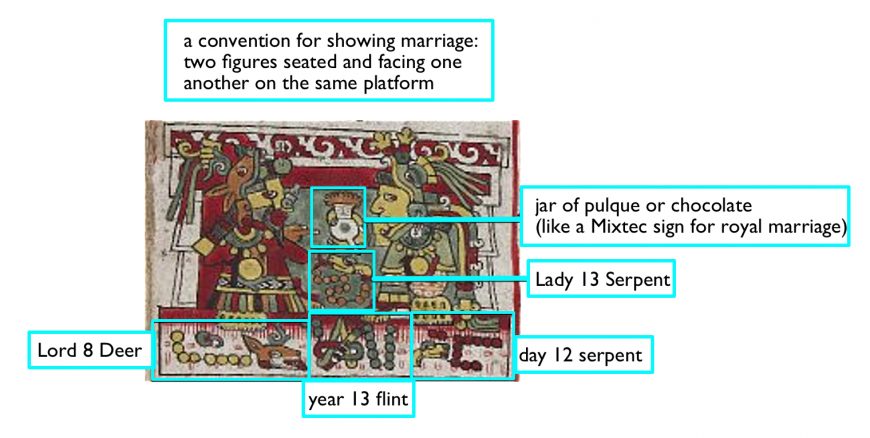Maya Vs. Mixtec written language

The Fenton Vase, 600-800 C.E., Maya, Late Classic period, polychrome ceramic, 17.2 cm diameter, Nebaj, Guatemala © Trustees of the British Museum
For my second blog post of this final week I am going to be discussing the Fenton Vase and compare it to my first post of this week. The Fenton Vase shows us a scene of a Maya ruler sitting criss crossed on a bench. He is wearing a gigantic head dress to symbolize that he is very important. The Maya ruler is pointing towards a gift basket full of tamales. The crossword looking box to the left of the Maya ruler contains glyphs. These glyphs list his name as well as all the other titles that are attributed to him. Referring back to professor Z’s YouTube video, the Maya written language (glyphs) is extremely difficult to read and understand. This is because there are many different meanings and words that pertain to different glyphs. For example, there are about nine glyphs that make the sound u. The Maya language was always written down dating back to 400 B.C.E. Come sixteenth century, Spanish missionaries burned and obliterated the Maya screen fold books. The missionaries also made the Mayas learn the Spanish alphabet. Because of this a lot of the Maya language was lost and there became no way to decipher what the different glyphs meant on monuments.

The Fenton Vase, 600-800 C.E., Maya, Late Classic period, polychrome ceramic, 17.2 cm diameter, Nebaj, Guatemala © Trustees of the British Museum
Above is the original picture of the vase just made flat so we can see all around the vase in a single flat picture. As we can see here it is much more difficult to understand what is going on compared to the Mixtec Rebus Writings. We are able to tell that the Maya culture was extremely more sophisticated because of the more in-depth understanding needed to be able to interpret the writings. Right off the bat we can tell that there is much more needed explanation for the Maya glyphs compared to the Mixtec Rebus writings. Comparing the two forms of communication is very important because there are similarities amongst the two cultures but even more differences that historians and archeologists can’t even understand yet.


Smart History Link: https://smarthistory.org/maya-the-fenton-vase/
“Maya: The Fenton Vase.” Smarthistory, smarthistory.org/maya-the-fenton-vase/.
“Mesoamerica, an Introduction.” Smarthistory, smarthistory.org/mesoamerica-an-introduction/.

Hello Justin! I wrote on the Fenton vase this week also. I was enamored by the vase. The detail on the headdress was super cool! Your attention to the comparison of the vases was a great read!
ReplyDeleteHey Justin,
ReplyDeleteThis is a good post. I really like that there is a flat complete image to look at. There's so much going on and the detail is impeccable. I think it would be interesting to see an exhibit of these kinds of pieces in person. This semester has definitely increased my appreciation of these cultures and their art/architecture. Overall, great post.
I have been waiting all semester to get to the Maya section! I must admit that I'm a little disappointed in the lack of information, but then again, I'm using google rather than scholarly books so maybe that's on me. I would love to see some of these ceramics in person. The details are phenomenal. Even after years of wear and tear they are stunning. I find these royals scenes to be more relaxed than what we have seen in other parts of the world. The headdresses are so elaborate I can't imagine how bad your neck would ache after an hour or two with it on.
ReplyDeleteHello,
ReplyDeleteIn your blog post, you did a good job at explaining the deeper meaning of the pictures depicted. For example, you said that the Mayan ruler in the first picture was portrayed to be important because he was wearing a huge head dress. I also like how you included so many visuals for us. Good job!
Amanda Garrett